If we want to save the planet, we have to give up some parts of our fast-paced lifestyle. Much like the Victory Speed Limit slowed down cars during World War II in order to consume less gas, designers today are asking, “Would you take a bit longer to travel somewhere if you knew it was better for the environment?”
And that’s the question Google is putting forth in its latest iteration of Google Maps.
In the near future, Google will fundamentally change the logic of Google Maps. Instead of showing you the fastest route from point A to point B by default, it will show you the greenest route by default. By referencing data from the U.S. Department of Energy’s National Renewable Energy, Google will be calculating factors such as fuel consumption, road incline, and traffic congestion to provide to you the route that is as climate-friendly as possible. (The company declined to make a designer available for an interview.)
[Image: Google]For the most part, you might not even notice a difference. Google will be listing the climate-friendly route when its ETA is about the same as a less climate-friendly route. However, in situations where making the eco-conscious decision will cost you significantly more time, Google will offer you the option to toggle between routes and choose which you’d prefer. You can even change your settings to have your route always default to the fastest option. But it’s unlikely that you will. One study found 95% of users never change the default settings of apps.
For years, Google has leveraged our unwillingness to dig for and change defaults to harvest our data. Now, it is leveraging these tendencies to prioritize the environment. It’s a refreshing twist.
To mark the eco-friendly routes, Google is opting for a green leaf icon (what it lacks in originality it makes up for in recognizability). The company is even choosing to include quantifiable stats to nudge you to the greener choice when available. In the company’s example, Google lists two routes: a 15-minute fast route and a 17-minute green route. Then it points out that the green route has 8% lower CO2 emissions on average.
What about bikes and trains, which are even better than driving? Google is going to include these modes of transportation in its emissions program too, similar to how they’re included as optional modes of transit today. The company says it will be using machine learning to figure out if you are a frequent biker or bus rider, to show those routes by default. You can also go into the settings of Google Maps and highlight your preferred modes of transportation, so that you aren’t constantly being shown buses when you prefer to take the train.
From a high level, the new Google Maps design will quietly nudge you toward greener behaviors. Sometimes those nudges will be invisible (you just see the greenest route by default). Sometimes those nudges will be broadcast (the user interface lists the facts and forces you to choose, for yourself, whether it’s time to be green or to be fast).
My only question is whether these Maps options could have unintended consequences. Google’s own Waze app has been criticized time and again for funneling rush-hour drivers down otherwise quiet neighborhood streets that weren’t really designed for high levels of traffic. Could the same happen for green routes? Or could routes that are green one day, due to Google’s nudging, suddenly be congested and less green another?
Similarly, I wonder if Google can find the right balance between giving you a pat on the back and pushing you to improve your behavior. When gas-guzzling pickup truck drivers turn off public transit options, they will be able to continue picking “green” driving routes. They’d keep seeing these green leaves, of course, which would reward their behavior, when maybe those drivers should consider biking or public transit once in a while instead.
The fact of the matter is that Google impacts human behavior at a scale few companies can. They do so everywhere from their own cafeterias and snack areas, where they hide colorful, tempting M&Ms inside opaque bins, to our emails, where Google AI autofills our personal notes with algorithmic suggestions. If we’re indeed handing over our autonomy to the decisions of a machine, we need that machine prioritizing our well-being in every sense of the word—though maybe not if it makes us late for work.
Recognize your brand’s excellence by applying to this year’s Brands That Matter Awards before the early-rate deadline, May 3.
